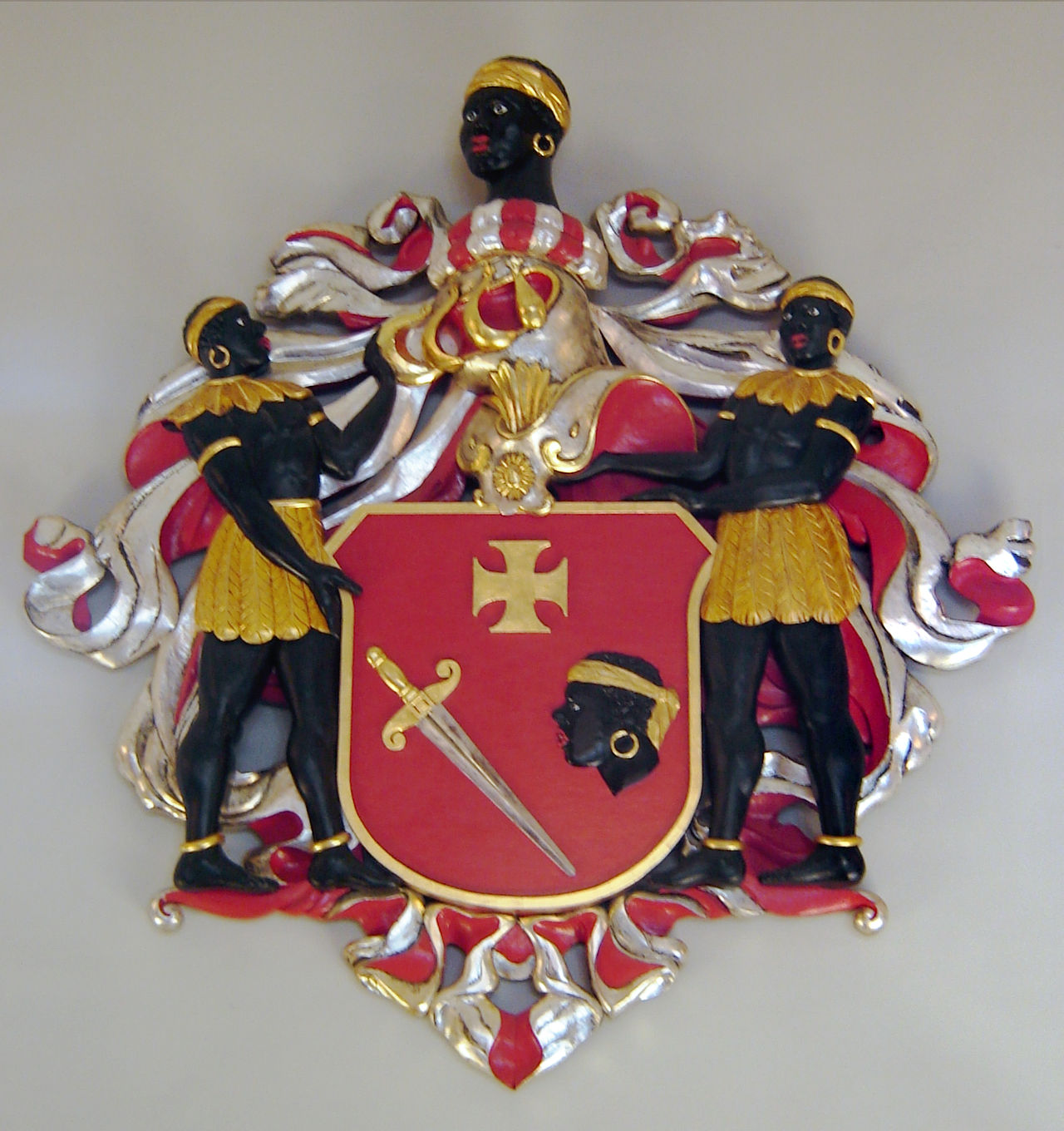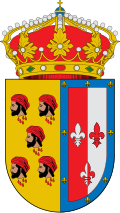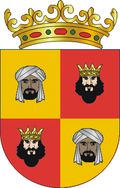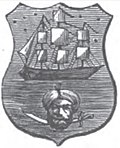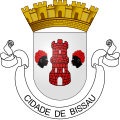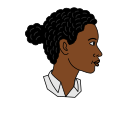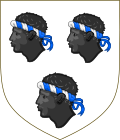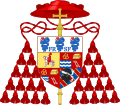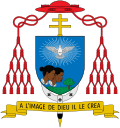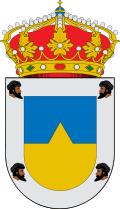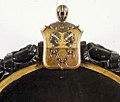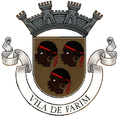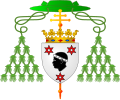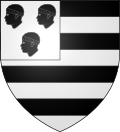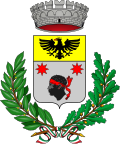A Moor’s head, since the 11th century, is a symbol depicting the head of a black moor. The precise origin of the Moor’s head is a subject of controversy. But the most likely explanation is that it is derived from the heraldic war flag of the Reconquista depicting the Cross of Alcoraz, symbolizing Peter I of Aragon and Pamplona’s victory over the “Moorish” kings of the Taifa of Zaragoza in the Battle of Alcoraz in 1096. The blindfold may originally have been a headband. Another theory claims that it is the Nubian Saint Maurice (3rd century AD).

A Moor's head, also known as a Maure, since the 11th century, is a symbol depicting the head of a black moor. The term moor came to define anyone who was African and Muslim.
Origin
The precise origin of the Moor's head as a heraldic symbol is a subject of controversy. The most likely explanation is that it is derived from the heraldic war flag of the Reconquista depicting the Cross of Alcoraz, symbolizing Peter I of Aragon and Pamplona's victory over the "Moorish" kings of the Taifa of Zaragoza in the Battle of Alcoraz in 1096. The headband may originally have been a blindfold.[1] Another theory claims that it represents the Egyptian Saint Maurice (3rd century AD).[2]
The earliest heraldic use of the Moor's head is first recorded in 1281, during the reign of Peter III of Aragon and represents the Cross of Alcoraz, which the King adopted as his personal coat of arms.[3] The Crown of Aragon had for a long time governed Sardinia and Corsica, having been granted the islands by the Pope, although they never really exercised formal control. The Moor's head became a symbol of the islands.[4]
Flags, seals, and emblems
This symbol is used in heraldry, vexillography, and political imagery.
Flag of Corsica
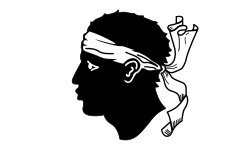
The main charge in the coat of arms in Corsica is a U Moru, Corsican for "The Moor". An early version is attested in the 14th-century Gelre Armorial, where an unblindfolded Moor's head represents Corsica as a territory of the Crown of Aragon. Interestingly, the Moor's head is attached to his shoulders and upper body, and he is alive and smiling. In 1736, it was used by both sides during the struggle for independence.[citation needed]
In 1760, General Pasquale Paoli ordered the necklace to be removed from the head and the blindfold raised. His reason, reported by his biographers, was "Les Corses veulent y voir clair. La liberté doit marcher au flambeau de la philosophie. Ne dirait-on pas que nous craignons la lumière ?" (English: "The Corsicans want to see clearly. Freedom must walk by the torch of philosophy. Won't they say that we fear the light?") The blindfold was thereafter changed to a headband.
The current flag of Corsica is the Bandera testa Mora, 'Flag with head of Moor', is male rather than female, and has a regular knot at the back of the head.
SC Bastia
The Moor's head appears on the logo for the Corsican football team SC Bastia, who play in the French football system's Ligue 2.[5]
Flag of Sardinia

The flag of Sardinia is informally known as the Four Moors (Italian: I quattro mori, Logudorese: Sos Bator Moros, Campidanese: Is Cuatru Morus) and comprises four Moor heads.
African Unification Front
The "Maure" is the African Unification Front's flag and emblem. The head is blindfolded representing the impartiality of justice, and the knot is tied into a stylized Adinkra symbol for omnipotence (Gye Nyame).[6]
Modern controversy

Critics in Switzerland have characterized the use of the Moor's head as racist, when used as a symbol by a workers guild.[7]
In 2012, activists requested the brewing company Mohrenbrauerei to remove the "Moor's head" from its bottles; the company declined, saying the design was part of heraldry used by the family who started the brewery.[8]
See also
References
- ^ "Corsica (France, Traditional province)". www.crwflags.com.
- ^ "Flag of Corsica". Traghetti Corsica EN. February 17, 2015.
- ^ ""Moor's head" Peter aragon - Google Search". www.google.com.
- ^ Martone, Eric (December 8, 2008). Encyclopedia of Blacks in European History and Culture [2 volumes]. ABC-CLIO. ISBN 9780313344497 – via Google Books.
- ^ Willis, Craig; Hughes, Will; Bober, Sergiusz. "ECMI Minorities Blog. National and Linguistic Minorities in the Context of Professional Football across Europe: Five Examples from Non-kin State Situations". ECMI. ECMI. Retrieved 27 March 2023.
- ^ "African Unification Front Flags & Emblems". Africanfront.org. Archived from the original on 2021-09-11. Retrieved 2019-01-14.
- ^ "Is the emblem of a Bern guild racist?". SWI swissinfo.ch.
- ^ "Racism in a beer logo (2012)". April 25, 2016.
Further reading
- "Revisiting the Symbology of Europe's Moorish Heraldry". Black Research Central. Retrieved July 19, 2020.
- Fierro, Maribel (2008). "Decapitation of Christians and Muslims in the medieval Iberian Peninsula: Narrative, images, contemporary perceptions". Comparative Literature Studies. 45 (2): 137–164. doi:10.1353/cls.0.0020. JSTOR 25659647. S2CID 161217907. Retrieved April 21, 2021.
- "Heart of Independent Sardinia". giampiero6's Orgosolo Page. Retrieved April 22, 2005.
- "Sa Bandela de Sos Bator Moros", Sardinian Autonomous Region, retrieved April 22, 2005 which in turn cites
- B. Fois (1990). Lo stemma dei quattro mori, breve storia dell'emblema dei Sardi. (editor Carlo Delfino) Sassari.
- "L'Histoire d'U Moru", Extraits de l'Ouvrage: "Trois Etudes Sur Paoli", retrieved April 22, 2005
- "U Moru (English translation)", Extracts from "Trois Etudes Sur Paoli", retrieved April 22, 2005
External links
 Media related to Moor heads in heraldry at Wikimedia Commons
Media related to Moor heads in heraldry at Wikimedia Commons
heraldic figure | |||||
| Upload media | |||||
| Instance of | |||||
|---|---|---|---|---|---|
| Subclass of | |||||
| Part of | |||||
| |||||
Subcategories
This category has the following 20 subcategories, out of 20 total.
Media in category "Moor heads in heraldry"
The following 200 files are in this category, out of 254 total.
(previous page) (next page)-
Blason-argent-3-têtes-de-Maure.svg 600 × 660; 5 KB
-
Blason-argent-tête-de-Maure.svg 600 × 660; 6 KB
-
Blason-or-3-têtes-de-Maure.svg 600 × 660; 5 KB
-
Blason-or-tête-de-Maure.svg 600 × 660; 6 KB
-
Meuble héraldique Maure chef.svg 600 × 660; 14 KB
-
Meuble héraldique tête de Maure.svg 351 × 343; 23 KB
-
Moor'sHeadWreathed svg element.svg 744 × 1,052; 42 KB
-
Tete-maure-neutre.jpg 100 × 126; 4 KB
-
Tête de maure.png 227 × 245; 7 KB
-
Blason Es famille Abruza (Alava).svg 603 × 763; 58 KB
-
Blason de la ville d'Adast (Hautes-Pyrénées).svg 600 × 660; 131 KB
-
Escudo de la Casa Real Afroboliviana.png 692 × 1,447; 481 KB
-
Escudo Real Afroboliviano.svg 782 × 1,640; 955 KB
-
Escudo de Alcanadre-La Rioja.svg 550 × 975; 550 KB
-
Coat of arms of the Kingdom of the Algarve.svg 684 × 932; 323 KB
-
Kingdom of the Algarve CoA.png 225 × 352; 26 KB
-
Escudo de Almudévar.svg 710 × 903; 366 KB
-
Coat of Arms of Almuñecar.svg 377 × 502; 182 KB
-
Escudo de Almuñécar (Granada) 2.svg 512 × 801; 50 KB
-
Escudo de Almuñécar (Granada) 3.svg 512 × 856; 58 KB
-
Escudo de Almuñécar (Granada).svg 512 × 801; 49 KB
-
Escudo almunecar.svg 320 × 500; 425 KB
-
Blason Es famille Amigot (Roncal).svg 603 × 763; 34 KB
-
Blason Es famille Anaut (Roncal).svg 603 × 763; 34 KB
-
Anhée wapen.svg 751 × 690; 99 KB
-
Araldiz Manno 045.png 168 × 189; 3 KB
-
Araldiz Manno 059.png 165 × 226; 18 KB
-
Araldiz Manno 060.png 160 × 220; 8 KB
-
Araldiz Manno 095.png 150 × 186; 6 KB
-
Araldiz Manno 270.png 229 × 296; 17 KB
-
Blason ville fr Argiusta-Moriccio (Corse-du-Sud).svg 600 × 660; 29 KB
-
Arms of Huesca Province.svg 869 × 954; 4.03 MB
-
Arms of Santiago Concha.svg 325 × 390; 778 KB
-
Arms of the house of Cavazzi (ancient).svg 430 × 500; 39 KB
-
Arms of the house of Cavazzi della Somaglia (16th centuy).svg 430 × 500; 835 KB
-
Arms of the house of Cavazzi della Somaglia.svg 430 × 500; 907 KB
-
Blason Es famille Arregui (Roncal).svg 603 × 763; 34 KB
-
Blason Es famille Arriaga (Roncal).svg 603 × 763; 34 KB
-
Coat of Arms of François III d'Aubusson, duke of La Feuillade.svg 893 × 992; 8.53 MB
-
AUT Waidhofen an der Ybbs COA.svg 262 × 310; 32 KB
-
Blason famille Avrillot (Champagne).svg 600 × 660; 27 KB
-
Avrillot.jpg 254 × 298; 40 KB
-
Coat of Arms of Baena.svg 885 × 1,238; 359 KB
-
Escudo de Baena (Córdoba).svg 512 × 637; 45 KB
-
Logoayto.jpg 75 × 110; 29 KB
-
Barcelo coat of arms majorca branch.JPG 609 × 756; 225 KB
-
Barcelo house mallorca branch heraldic.jpg 671 × 866; 337 KB
-
Basarabia Sigilium Vitezovic.svg 550 × 916; 192 KB
-
Blason César Berthier (1765-1819).svg 600 × 660; 351 KB
-
Blason Es famille Billotx (Roncal).svg 603 × 763; 34 KB
-
Blason gw Bissau.svg 1,340 × 1,331; 135 KB
-
Bissau.PNG 569 × 572; 340 KB
-
Black man's head with bandana.svg 500 × 600; 15 KB
-
Black man's head.svg 500 × 600; 13 KB
-
Black woman's head.svg 256 × 256; 24 KB
-
BlackmoreArms.png 810 × 933; 75 KB
-
Blaker Escutcheon.png 307 × 337; 49 KB
-
Blason de la ville de Blaringhem (59) Nord-France.svg 600 × 660; 165 KB
-
Blason Anhée.svg 1,106 × 910; 132 KB
-
Blason de l'abbé Paul de Bruyn (Belgique).svg 600 × 660; 27 KB
-
Blason famille fr Billiet.svg 600 × 660; 54 KB
-
Blason famille fr Claude Charles Aubry (Baron).svg 602 × 662; 78 KB
-
Blason famille fr Claude Charles Aubry (Comte).svg 600 × 660; 80 KB
-
Blason famille fr Eugène Charles François Richepanse (baron).svg 602 × 662; 23 KB
-
Blason famille fr Louis Alexandre Amélie Bauduy (chevalier).svg 600 × 660; 76 KB
-
Blason famille fr MOREAU DE BONREPOS.svg 600 × 660; 67 KB
-
Blason morel-fatio.jpg 452 × 586; 48 KB
-
Blason ville be Boezinge.svg 450 × 500; 43 KB
-
Blason ville fr Richemont (Moselle).svg 600 × 660; 85 KB
-
Coat of arms of Henri-Marie-Gaston de Bonnechose.svg 1,150 × 1,227; 152 KB
-
Boretti POL COA.svg 730 × 975; 221 KB
-
Brabant blason champ.jpg 254 × 297; 47 KB
-
Blason d'Arnaud de La Briffe de Ferrières.svg 600 × 660; 68 KB
-
Briseur.png 257 × 290; 170 KB
-
Coat of Arms of Briviesca.svg 386 × 607; 143 KB
-
Escudo de Briviesca (Burgos).svg 560 × 910; 176 KB
-
Coat of arms of François-Xavier Bustillo (cardinal).svg 1,150 × 1,226; 126 KB
-
Coat of arms of François-Xavier Bustillo.svg 1,150 × 1,227; 130 KB
-
Büren Wappen 2.jpg 177 × 214; 17 KB
-
Escudo de Cabra (Córdoba).svg 512 × 599; 106 KB
-
Escudo de Cádiar (Granada).svg 512 × 894; 55 KB
-
Escudo de Cádiar.svg 550 × 975; 241 KB
-
CallardArms.png 654 × 752; 95 KB
-
Canning arms.svg 362 × 423; 267 KB
-
Blason ville fr Castelsarrasin (Tarn-et-Garonne).svg 600 × 660; 34 KB
-
Blason ville fr Castelsarrasin-Empire.svg 600 × 660; 160 KB
-
Blason ville fr Castiglione (Haute-Corse).svg 600 × 660; 25 KB
-
Blason ville Ciamannacce corse du sud.svg 600 × 660; 76 KB
-
CLAN MACLELLAN.jpg 1,328 × 1,660; 202 KB
-
Clemens Wenzeslaus von Sachsen zur Primizfeier.jpg 476 × 781; 89 KB
-
Coa fam ITA andrei5 khi.jpg 128 × 144; 13 KB
-
Coa fam ITA brunati.jpg 840 × 1,080; 448 KB
-
Coa fam ITA Malagodi 2.PNG 485 × 615; 20 KB
-
Coa fam ITA Malagodi 3.PNG 486 × 613; 38 KB
-
Coa fam ITA Malagodi 4.PNG 486 × 613; 38 KB
-
COA family fr Favre (Savoy).svg 600 × 660; 66 KB
-
Coa Hungary Family Apponyi.svg 260 × 300; 854 KB
-
Coa Hungary Town Mohora.svg 480 × 630; 335 KB
-
Coa Illustration Elements Moor's Head Couped Maintaining a Crown.svg 275 × 333; 326 KB
-
Coa Illustration Elements Moor's Head Couped.svg 1,043 × 1,267; 75 KB
-
COA of Vila do Bispo municipality (Portugal).png 413 × 434; 37 KB
-
CoA Quarto di Santa Maria.svg 200 × 270; 72 KB
-
Coa Rákóczi de Rákócz family.svg 584 × 674; 867 KB
-
Coat of arms antonio barcelo y pont de la terra.jpg 330 × 310; 31 KB
-
Coat of Arms of Bissau (1941-1974).svg 600 × 577; 106 KB
-
Coat of Arms of Cardinal Giulio Maria della Somaglia.svg 561 × 492; 1.19 MB
-
Coat of arms of David de Morlot (David van Marlot).svg 601 × 661; 19 KB
-
Coat of arms of Dieudonné Nzapalainga.svg 1,150 × 1,226; 304 KB
-
Coat of Arms of Huesca Province.svg 466 × 614; 3.49 MB
-
Coat of Arms of Samuel Bangs.svg 395 × 505; 1.41 MB
-
Coat of Arms of the 1st Brigate Aragón (Polyvalent Brigade).svg 402 × 606; 3.13 MB
-
Coat of Arms of the 1st Mountain Hunters Brigade Aragón.svg 490 × 607; 1.74 MB
-
Coat of Arms of the Mountain Troops Command Aragón.svg 555 × 607; 2.07 MB
-
Coat of Arms of Thomas Poynton Ives.svg 395 × 478; 1.5 MB
-
Complete Guide to Heraldry Fig254.png 310 × 380; 16 KB
-
Cross of Alcoraz Arms.svg 808 × 950; 141 KB
-
BLASON DEMORE.jpg 118 × 143; 5 KB
-
Eblem of AUF.jpg 382 × 190; 10 KB
-
Blason Es famille Echandi (Roncal).svg 603 × 763; 34 KB
-
Ecusson Richemont.jpg 319 × 185; 56 KB
-
Eisenberg Rathaus Portal Wappen.jpg 2,765 × 2,138; 1.92 MB
-
Blason Es famille Eizaguirre (Guipuscoa).svg 603 × 763; 334 KB
-
Escudo d'Aragón.svg 383 × 578; 260 KB
-
Escudo de Almoguera (Guadalajara).svg 550 × 970; 315 KB
-
Escudo de Antonio Jorge y Galbán.svg 1,082 × 1,089; 105 KB
-
Escudo de Aragón, Vagad y Hurus, 1499.jpg 469 × 671; 340 KB
-
Escudo de Cabezas de Alambre.svg 550 × 956; 217 KB
-
Escudo de la san millan de la cogolla.png 572 × 600; 141 KB
-
Escudo de Moriana.svg 550 × 958; 295 KB
-
Escudo de San Millán de la Cogolla.jpg 704 × 1,248; 91 KB
-
Escudo de Tineo.jpg 349 × 461; 55 KB
-
Blason Fr famille Etcheverry (Bayonne).svg 600 × 660; 51 KB
-
Familiewapen met naam van Jacob Evertsen in banderol.jpg 592 × 700; 95 KB
-
Farim.PNG 437 × 431; 191 KB
-
Blason Fouquières-lès-Béthune.svg 600 × 660; 64 KB
-
Blason Es famille Gaston (Roncal).svg 603 × 763; 34 KB
-
Escudo de Gea de Albarracin.svg 550 × 975; 574 KB
-
Blason n° 1702 (Folio 121v de l'Armorial de Gelre).svg 600 × 660; 90 KB
-
Gelre Folio 62r.jpg 673 × 1,125; 688 KB
-
Ecu-Olivier de Germay.svg 600 × 660; 26 KB
-
Blason Charles Le Goux de La Berchere.svg 1,060 × 887; 386 KB
-
Blason ville fr Grossa (Corse-du-Sud).svg 600 × 660; 93 KB
-
Hb-malaquin.jpg 219 × 301; 24 KB
-
Heraldic Emblems of the Kingdom of Aragon with supporters.svg 1,453 × 950; 4.88 MB
-
Blason Nicolas Heurteloup (1750-1812).svg 600 × 660; 119 KB
-
Escudo de Huesa (Jaén) 2.svg 512 × 688; 124 KB
-
Escudo de Huesa (Jaén).svg 512 × 728; 160 KB
-
Escudo de la Provincia de Huesca.svg 700 × 900; 999 KB
-
Institutional Lisbon underground grafitti (77512465).jpg 2,493 × 1,788; 1.63 MB
-
Escudo de Iznate.svg 550 × 975; 999 KB
-
John Hullock Coat of Arms.jpg 2,448 × 3,264; 1.37 MB
-
Blason Es famille Labayru (Roncal).svg 603 × 763; 44 KB
-
Blason Es famille Larrimpe (Roncal).svg 603 × 763; 36 KB
-
Blason ville fr Lascazères (65).svg 600 × 660; 54 KB
-
Blason ville fr Layrisse (65).svg 600 × 660; 36 KB
-
Blason Jean Louis Leclerc (1767-1822) comte de l’Empire.svg 600 × 660; 5.03 MB
-
Blason Nicolas Marin, baron Leclerc des Essarts (1770-1820).svg 600 × 660; 4.98 MB
-
Blason Nicolas Marin, comte Leclerc des Essarts (1770-1820).svg 600 × 660; 5 MB
-
Blason Lennik.svg 600 × 660; 83 KB
-
Lennik wapen.svg 722 × 707; 603 KB
-
Blason Linkebeek.svg 610 × 670; 36 KB
-
Linkebeek wapen.svg 482 × 555; 34 KB
-
Logo istituzionale Regione Sardegna (2021).svg 530 × 644; 120 KB
-
Blason de la ville de Maizeroy (Moselle).svg 600 × 660; 158 KB
-
Blason imaginaire de Malaquin le Danois.svg 600 × 660; 51 KB
-
Armes de van Maldeghem.svg 600 × 660; 122 KB
-
Blason famille be Malou.svg 600 × 660; 13 KB
-
Blason Marault.svg 600 × 660; 133 KB
-
Marken wapen HRVA.svg 373 × 433; 90 KB
-
Marken-wapen.svg 346 × 425; 44 KB
-
Blason ville fr Marsilly 57.svg 600 × 660; 464 KB
-
Blason ville fr Matringhem 62.svg 600 × 660; 20 KB
-
Blason famille fr de Mauregard.svg 600 × 660; 92 KB
-
Blason ville fr Mauriac (Gironde).svg 600 × 660; 6 KB
-
Blason de Frédéric-Guillaume Maurice - 1er Empire - Baron Maire.svg 600 × 660; 13 KB
-
Blason de Frédéric-Guillaume Maurice - 1er Empire.svg 600 × 660; 12 KB
-
Blason ville fr Mauroux (Gers).svg 600 × 660; 86 KB
-
Blason alias ville fr Maurs (Cantal).svg 600 × 660; 11 KB
-
MacLellan crest.jpg 300 × 384; 24 KB
-
MacLellan crest.png 679 × 857; 397 KB
-
Blason Es famille Mea (Roncal).svg 603 × 763; 48 KB
-
Armoiries de Milberg 2.svg 600 × 660; 15 KB
-
Armes de Montpellier.svg 600 × 660; 71 KB
-
Blason ville fr Morancé (Rhône).svg 600 × 660; 147 KB
-
Morazzone-Stemma.svg 419 × 502; 352 KB
-
Blason Famille Le More.svg 600 × 660; 7 KB
-
Le More.svg 600 × 660; 61 KB
-
Blasonmorey.png 600 × 660; 55 KB
-
Blason famille fr Moricaud.svg 600 × 660; 47 KB
-
Mornago-Stemma.svg 419 × 502; 264 KB
-
MortimerAliasTannerArms.png 810 × 932; 75 KB
-
Escudo de Mozárbez.svg 550 × 975; 253 KB
-
Escudo de Muelas de los Caballeros.svg 550 × 958; 489 KB

